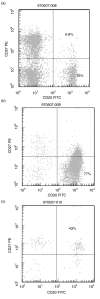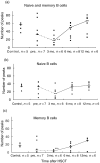Memory B lymphocytes determine repertoire oligoclonality early after haematopoietic stem cell transplantation
- PMID: 12974769
- PMCID: PMC1808844
- DOI: 10.1046/j.1365-2249.2003.02260.x
Memory B lymphocytes determine repertoire oligoclonality early after haematopoietic stem cell transplantation
Abstract
The objective of this study was to investigate if oligoclonality of the Ig repertoire post-haematopoietic stem cell transplantation (HSCT) is restricted to memory B lymphocytes or if it is a general property among B lymphocytes. As a measure of B lymphocyte repertoire diversity, we have analysed size distribution of polymerase chain reaction (PCR) amplified Ig H complementarity determining region 3 (CDR3) in naive and memory B lymphocytes isolated from patients before HSCT and at 3, 6 and 12 months after HSCT as well as from healthy controls. We demonstrate a limited variation of the IgH CDR3 repertoire in the memory B lymphocyte population compared to the naive B cell population. This difference was significant at 3 and 6 months post-HSCT. Compared to healthy controls there is a significant restriction of the memory B lymphocyte repertoire at 3 months after HSCT, but not of the naive B lymphocyte repertoire. Twelve months after HSCT, the IgH CDR3 repertoire in both memory and naive B lymphocytes are as diverse as in healthy controls. Thus, our findings suggest a role for memory B cells in the restriction of the oligoclonal B cell repertoire observed early after HSCT, which may be of importance when considering reimmunization of transplanted patients.
Figures






Similar articles
-
Reconstitution of the Ig heavy chain CDR3 repertoire after allogeneic haematopoietic stem cell transplantation with myeloablative or reduced-intensity conditioning regimens.Scand J Immunol. 2005 Jan;61(1):72-81. doi: 10.1111/j.0300-9475.2005.01528.x. Scand J Immunol. 2005. PMID: 15644125 Clinical Trial.
-
Ig heavy chain third complementarity determining regions (H CDR3s) after stem cell transplantation do not resemble the developing human fetal H CDR3s in size distribution and Ig gene utilization.Blood. 1998 Oct 15;92(8):2802-14. Blood. 1998. PMID: 9763565
-
Ig heavy chain CDR3 size diversities are similar after conventional peripheral blood and ex vivo expanded hematopoietic cell transplants.Bone Marrow Transplant. 2001 Feb;27(4):413-24. doi: 10.1038/sj.bmt.1702794. Bone Marrow Transplant. 2001. PMID: 11313671
-
Ex vivo-expanded hematopoietic cell graft recipients exhibit T cell repertoire diversity similar to that seen after conventional stem cell transplants.J Hematother Stem Cell Res. 2001 Feb;10(1):53-66. doi: 10.1089/152581601750098237. J Hematother Stem Cell Res. 2001. PMID: 11276359 Review.
-
Translational Mini-Review Series on B cell subsets in disease. Reconstitution after haematopoietic stem cell transplantation - revelation of B cell developmental pathways and lineage phenotypes.Clin Exp Immunol. 2012 Jan;167(1):15-25. doi: 10.1111/j.1365-2249.2011.04469.x. Clin Exp Immunol. 2012. PMID: 22132880 Free PMC article. Review.
Cited by
-
Immune reconstitution and implications for immunotherapy following haematopoietic stem cell transplantation.Best Pract Res Clin Haematol. 2008 Sep;21(3):579-96. doi: 10.1016/j.beha.2008.06.003. Best Pract Res Clin Haematol. 2008. PMID: 18790456 Free PMC article. Review.
-
National Institutes of Health Hematopoietic Cell Transplantation Late Effects Initiative: The Immune Dysregulation and Pathobiology Working Group Report.Biol Blood Marrow Transplant. 2017 Jun;23(6):870-881. doi: 10.1016/j.bbmt.2016.10.001. Epub 2016 Oct 14. Biol Blood Marrow Transplant. 2017. PMID: 27751936 Free PMC article. Review.
-
Mass Cytometry for the Assessment of Immune Reconstitution After Hematopoietic Stem Cell Transplantation.Front Immunol. 2018 Jul 26;9:1672. doi: 10.3389/fimmu.2018.01672. eCollection 2018. Front Immunol. 2018. PMID: 30093901 Free PMC article. Review.
-
T cell regeneration after immunological injury.Nat Rev Immunol. 2021 May;21(5):277-291. doi: 10.1038/s41577-020-00457-z. Epub 2020 Oct 23. Nat Rev Immunol. 2021. PMID: 33097917 Free PMC article. Review.
-
Immune Reconstitution after Allogeneic Hematopoietic Stem Cell Transplantation.Front Immunol. 2016 Nov 17;7:507. doi: 10.3389/fimmu.2016.00507. eCollection 2016. Front Immunol. 2016. PMID: 27909435 Free PMC article. Review.
References
-
- Raaphorst FM. Reconstitution of the B cell repertoire after bone marrow transplantation does not recapitulate human fetal development. Bone Marrow Transplant. 1999;24:1267–72. - PubMed
-
- Storek J, Saxon A. Reconstitution of B cell immunity following bone marrow transplantation. Bone Marrow Transplant. 1992;9:395–408. - PubMed
-
- Atkinson K. Reconstruction of the haemopoietic and immune systems after marrow transplantation. Bone Marrow Transplant. 1990;5:209–26. - PubMed
-
- Storek J, Espino G, Dawson MA, et al. Low B-cell and monocyte counts on day 80 are associated with high infection rates between days 100 and 365 after allogeneic marrow transplantation. Blood. 2000;96:3290–3. - PubMed
-
- Agematsu K, Nagumo H, Yang FC, et al. B cell subpopulations separated by CD27 and crucial collaboration of CD27+ B cells and helper T cells in immunoglobulin production. Eur J Immunol. 1997;27:2073–9. - PubMed
Publication types
MeSH terms
Substances
LinkOut - more resources
Full Text Sources
Research Materials

